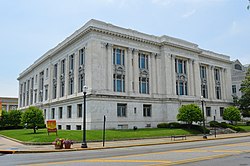Madison County, Illinois | |
|---|---|
 Madison County Courthouse in Edwardsville | |
 Location within the U.S. state of Illinois | |
 Illinois's location within the U.S. | |
| Coordinates: 38°50′N89°55′W / 38.83°N 89.91°W | |
| Country | |
| State | |
| Founded | September 14, 1812 |
| Named after | James Madison |
| Seat | Edwardsville |
| Largest city | Granite City |
| Area | |
• Total | 741 sq mi (1,920 km2) |
| • Land | 716 sq mi (1,850 km2) |
| • Water | 25 sq mi (65 km2) 3.4% |
| Population (2020) | |
• Total | 264,776 |
• Estimate (2024) | 263,017 |
| • Density | 370/sq mi (143/km2) |
| Time zone | UTC−6 (Central) |
| • Summer (DST) | UTC−5 (CDT) |
| Congressional districts | 13th, 15th |
| Website | www |
Madison County is located in the U.S. state of Illinois. It is a part of the Metro East in southern Illinois. According to the 2020 census, it had a population of 264,776, [2] making it the eighth-most populous county in Illinois and the most populous in the southern portion of the state. The county seat is Edwardsville, and the largest city is Granite City. [3]
Contents
- History
- Geography
- Climate and weather
- Adjacent counties and city
- Parks and Reserves
- Transportation
- Major highways
- Demographics
- 2020 census
- 2010 census
- Communities
- Cities
- Villages
- Census Designated Places
- Other unincorporated and historic communities
- Townships
- Islands
- Historic Settlements
- Population ranking
- Politics
- Education
- See also
- References
- External links
Madison County is part of the Metro East region of Greater St. Louis. The pre-Columbian city of Cahokia Mounds, a World Heritage Site, was located near Collinsville. Edwardsville is home to Southern Illinois University Edwardsville. To the north, Alton is known for its abolitionist and American Civil War-era history. It is also the home of the Southern Illinois University School of Dental Medicine. Godfrey, the village named for Captain Benjamin Godfrey, offers Lewis and Clark Community College formerly the Monticello Female Seminary.











